Jongju Shin
Gallery Sampling for Robust and Fast Face Identification
May 12, 2023Abstract:Deep learning methods have been achieved brilliant results in face recognition. One of the important tasks to improve the performance is to collect and label images as many as possible. However, labeling identities and checking qualities of large image data are difficult task and mistakes cannot be avoided in processing large data. Previous works have been trying to deal with the problem only in training domain, however it can cause much serious problem if the mistakes are in gallery data of face identification. We proposed gallery data sampling methods which are robust to outliers including wrong labeled, low quality, and less-informative images and reduce searching time. The proposed sampling-by-pruning and sampling-by-generating methods significantly improved face identification performance on our 5.4M web image dataset of celebrities. The proposed method achieved 0.0975 in terms of FNIR at FPIR=0.01, while conventional method showed 0.3891. The average number of feature vectors for each individual gallery was reduced to 17.1 from 115.9 and it can provide much faster search. We also made experiments on public datasets and our method achieved 0.1314 and 0.0668 FNIRs at FPIR=0.01 on the CASIA-WebFace and MS1MV2, while the convectional method did 0.5446, and 0.1327, respectively.
BroadFace: Looking at Tens of Thousands of People at Once for Face Recognition
Aug 15, 2020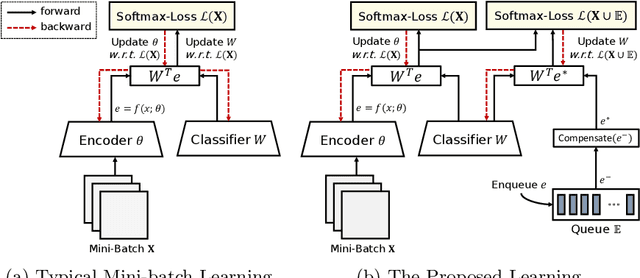



Abstract:The datasets of face recognition contain an enormous number of identities and instances. However, conventional methods have difficulty in reflecting the entire distribution of the datasets because a mini-batch of small size contains only a small portion of all identities. To overcome this difficulty, we propose a novel method called BroadFace, which is a learning process to consider a massive set of identities, comprehensively. In BroadFace, a linear classifier learns optimal decision boundaries among identities from a large number of embedding vectors accumulated over past iterations. By referring more instances at once, the optimality of the classifier is naturally increased on the entire datasets. Thus, the encoder is also globally optimized by referring the weight matrix of the classifier. Moreover, we propose a novel compensation method to increase the number of referenced instances in the training stage. BroadFace can be easily applied on many existing methods to accelerate a learning process and obtain a significant improvement in accuracy without extra computational burden at inference stage. We perform extensive ablation studies and experiments on various datasets to show the effectiveness of BroadFace, and also empirically prove the validity of our compensation method. BroadFace achieves the state-of-the-art results with significant improvements on nine datasets in 1:1 face verification and 1:N face identification tasks, and is also effective in image retrieval.
GroupFace: Learning Latent Groups and Constructing Group-based Representations for Face Recognition
May 25, 2020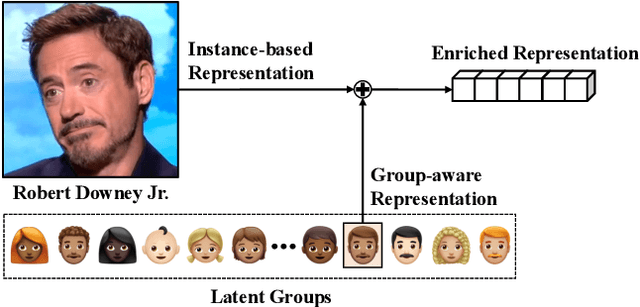


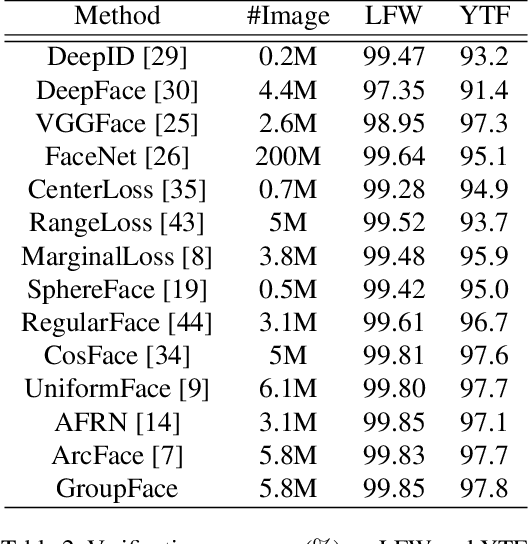
Abstract:In the field of face recognition, a model learns to distinguish millions of face images with fewer dimensional embedding features, and such vast information may not be properly encoded in the conventional model with a single branch. We propose a novel face-recognition-specialized architecture called GroupFace that utilizes multiple group-aware representations, simultaneously, to improve the quality of the embedding feature. The proposed method provides self-distributed labels that balance the number of samples belonging to each group without additional human annotations, and learns the group-aware representations that can narrow down the search space of the target identity. We prove the effectiveness of the proposed method by showing extensive ablation studies and visualizations. All the components of the proposed method can be trained in an end-to-end manner with a marginal increase of computational complexity. Finally, the proposed method achieves the state-of-the-art results with significant improvements in 1:1 face verification and 1:N face identification tasks on the following public datasets: LFW, YTF, CALFW, CPLFW, CFP, AgeDB-30, MegaFace, IJB-B and IJB-C.
Uncorrelated Feature Encoding for Faster Image Style Transfer
Jul 04, 2018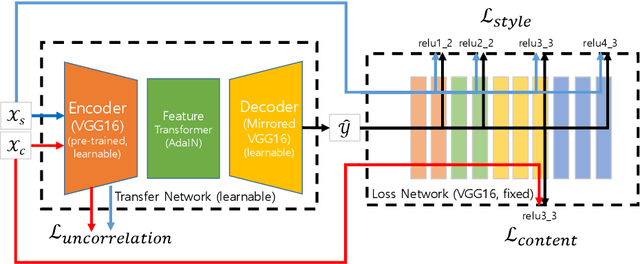
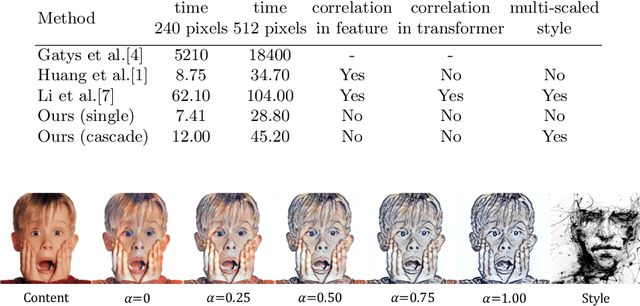


Abstract:Recent fast style transfer methods use a pre-trained convolutional neural network as a feature encoder and a perceptual loss network. Although the pre-trained network is used to generate responses of receptive fields effective for representing style and content of image, it is not optimized for image style transfer but rather for image classification. Furthermore, it also requires a time-consuming and correlation-considering feature alignment process for image style transfer because of its inter-channel correlation. In this paper, we propose an end-to-end learning method which optimizes an encoder/decoder network for the purpose of style transfer as well as relieves the feature alignment complexity from considering inter-channel correlation. We used uncorrelation loss, i.e., the total correlation coefficient between the responses of different encoder channels, with style and content losses for training style transfer network. This makes the encoder network to be trained to generate inter-channel uncorrelated features and to be optimized for the task of image style transfer which maintained the quality of image style only with a light-weighted and correlation-unaware feature alignment process. Moreover, our method drastically reduced redundant channels of the encoded feature and this resulted in the efficient size of structure of network and faster forward processing speed. Our method can also be applied to cascade network scheme for multiple scaled style transferring and allows user-control of style strength by using a content-style trade-off parameter.
Face Alignment Robust to Pose, Expressions and Occlusions
Jul 19, 2017



Abstract:We propose an Ensemble of Robust Constrained Local Models for alignment of faces in the presence of significant occlusions and of any unknown pose and expression. To account for partial occlusions we introduce, Robust Constrained Local Models, that comprises of a deformable shape and local landmark appearance model and reasons over binary occlusion labels. Our occlusion reasoning proceeds by a hypothesize-and-test search over occlusion labels. Hypotheses are generated by Constrained Local Model based shape fitting over randomly sampled subsets of landmark detector responses and are evaluated by the quality of face alignment. To span the entire range of facial pose and expression variations we adopt an ensemble of independent Robust Constrained Local Models to search over a discretized representation of pose and expression. We perform extensive evaluation on a large number of face images, both occluded and unoccluded. We find that our face alignment system trained entirely on facial images captured "in-the-lab" exhibits a high degree of generalization to facial images captured "in-the-wild". Our results are accurate and stable over a wide spectrum of occlusions, pose and expression variations resulting in excellent performance on many real-world face datasets.
 Add to Chrome
Add to Chrome Add to Firefox
Add to Firefox Add to Edge
Add to Edge